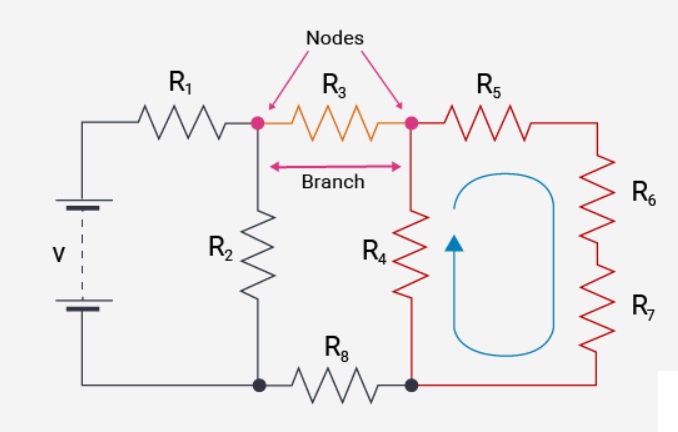Questions and Answers regarding Kirchhoff’s voltage and current laws in simple series and parallel resistor circuits:
Questions:
1. What are Kirchhoff’s voltage and current laws?
2. How do Kirchhoff’s laws apply to series resistor circuits?
3. How do Kirchhoff’s laws apply to parallel resistor circuits?
4. What is the principle behind Kirchhoff’s voltage law (KVL)?
5. Can you explain Kirchhoff’s current law (KCL) in simple terms?
6. How do you apply KVL in a series resistor circuit?
7. How do you apply KCL in a parallel resistor circuit?
8. What are the key steps in solving a circuit using Kirchhoff’s laws?
Answers:
1. What are Kirchhoff’s voltage and current laws?
Kirchhoff’s voltage law (KVL) states that the sum of the voltages around any closed loop in a circuit is equal to zero. Kirchhoff’s current law (KCL) states that the total current entering a junction or node in a circuit is equal to the total current leaving that junction or node.
2. How do Kirchhoff’s laws apply to series resistor circuits?
In a series resistor circuit, KVL states that the sum of the voltages across each resistor in the loop equals the total voltage of the circuit, and KCL states that the current remains constant throughout the circuit.
3. How do Kirchhoff’s laws apply to parallel resistor circuits?
In a parallel resistor circuit, KVL states that the voltage across each branch of the circuit is the same, and KCL states that the total current entering the node equals the total current leaving the node.
4. What is the principle behind Kirchhoff’s voltage law (KVL)?
KVL is based on the conservation of energy principle, stating that the total energy supplied by the voltage source must equal the total energy consumed by the circuit elements.
5. Can you explain Kirchhoff’s current law (KCL) in simple terms?
KCL simply states that the sum of all currents entering a junction equals the sum of all currents leaving that junction. In other words, what goes in must come out.
6. How do you apply KVL in a series resistor circuit?
To apply KVL in a series resistor circuit, you sum up the voltage drops across each resistor in the loop and equate it to the total voltage of the circuit.
7. How do you apply KCL in a parallel resistor circuit?
To apply KCL in a parallel resistor circuit, you sum up all the currents entering the node and equate it to the sum of all currents leaving the node.
8. What are the key steps in solving a circuit using Kirchhoff’s laws?
The key steps include:
- Identify and label all nodes and loops in the circuit.
- Apply KCL at each node to write equations for the currents.
- Apply KVL around each loop to write equations for the voltages.
- Solve the resulting system of equations to find the unknown currents or voltages.

